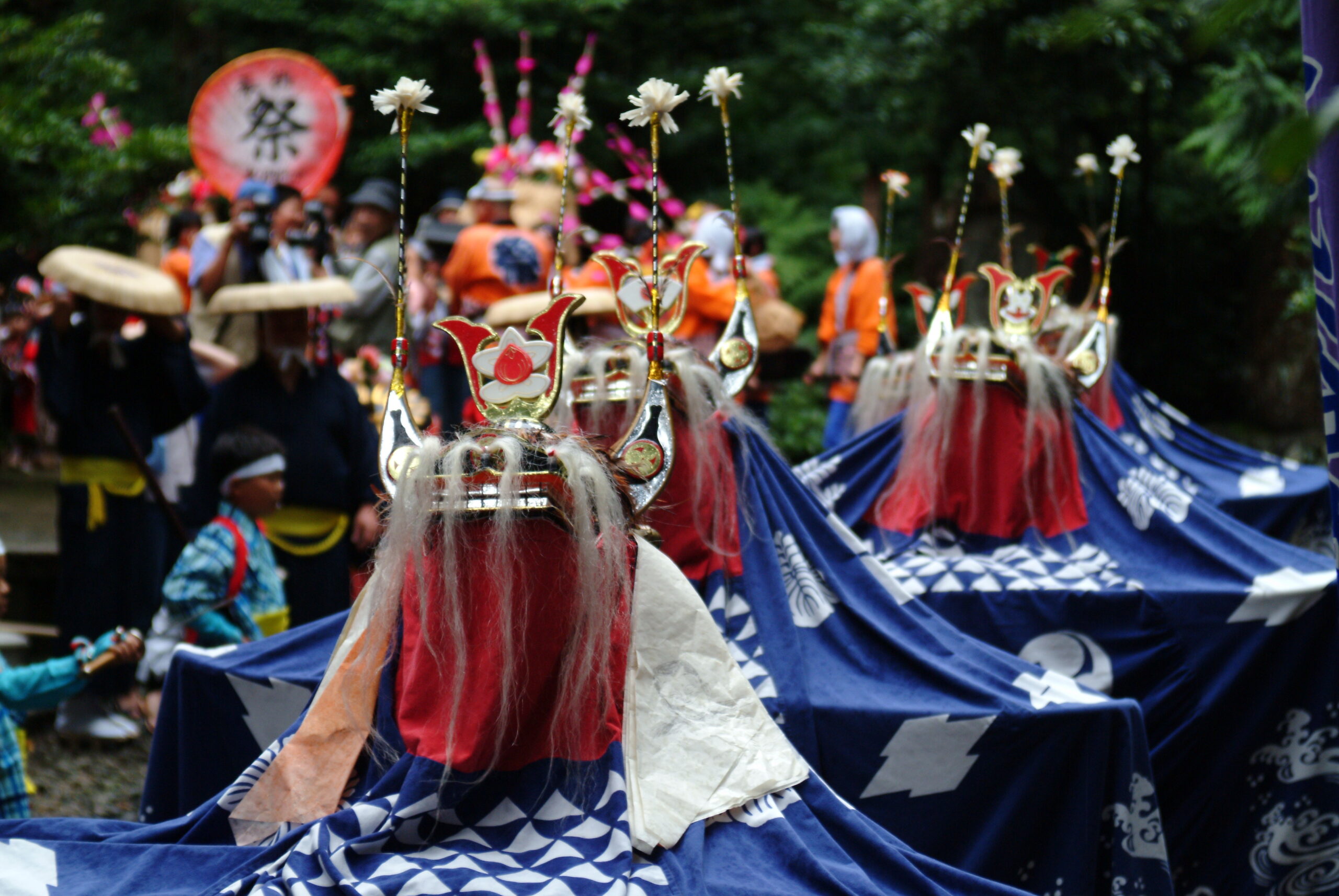
(August 2025 Festival) Where to see the Fujishima Lion Dance
In the Fujishima area, lion dances are so widely preserved and passed down that it is known as the “Land of Lions.” Notable examples can be found in villages such as Oya 大谷, Soegawa 添川, Higashihorikoshi 東堀越, or Watamae 渡前. While the exact origins of the dances in each of these communities are unclear, they are believed to be quite old. It is said that the art of the lion dance was first learned by the Tang dynasty from the West and later brought to Japan from Tang China. These dances have been performed as a ritual to drive away evil spirits.
The lion used in the dance is a single-person type, and there are five main lions: the central lion (nakajishi), the banner lion (hatajishi), the egret (shirasagi), the male lion (ojishi), and the female lion (mejishi), with the central lion taking the lead in performance. The decorations on the lion’s head differ depending on the lion. From the head hangs a curtain, a drum is attached in front of the belly, and a hoop-like shoulder frame is worn. In addition to the lions, the full troupe consists of about 30 people, including cross-dressed sasara players (playing a bamboo instrument), sword performers, stick performers, and singers. Accompanied by songs and the beat of drums, the lions leap and dance energetically.
While the musical pieces vary slightly by location, they often include “Great Dance,” “Bridge Crossing,” “Curtain Hanging,” “Madness of the Female Lion,” “Bow Dance,” and “Grass Tossing,” which are combined as appropriate. The dances are often performed during Obon-centered festivals, starting with a “spirit-entering” ceremony. The troupe first dances at the local shrine and then, upon request, visits and performs at the homes of parishioners.
This type of dance broadly consists of two key elements. One is the lion appearing as a divine messenger—or even as a deity itself—to bless the village and its households with happiness.
The second element is rooted in the belief that lions originally symbolized misfortune or were creatures that ravaged fields and crops. The lion first appears in this form. However, people of old believed that such a lion also had the power to suppress evil spirits. If venerated as a god, the lion would repent and pledge to serve as a guardian that subdues malevolent forces, bringing happiness to people and protecting agriculture.
When the lion, having once been subdued (appuku), is reborn with new divine vitality, the sasara player appears, and the lion performs a joyful frenzied dance. The role of subduing the lion belongs to the sword and stick performers. Another notable element is a scene called “the hiding of the female lion,” in which two male lions compete for her affection. In this way, the lion embodies intense expressions of romantic passion, representing a primitive prayer for fertility and abundance.
Moreover, the dance itself is said to be derived from the tradition of Buddhist chanting dances (nenbutsu odori), which developed from the medieval period onward.
Where to watch the Fujishima Lion Dance?
August 14th (Thursday)
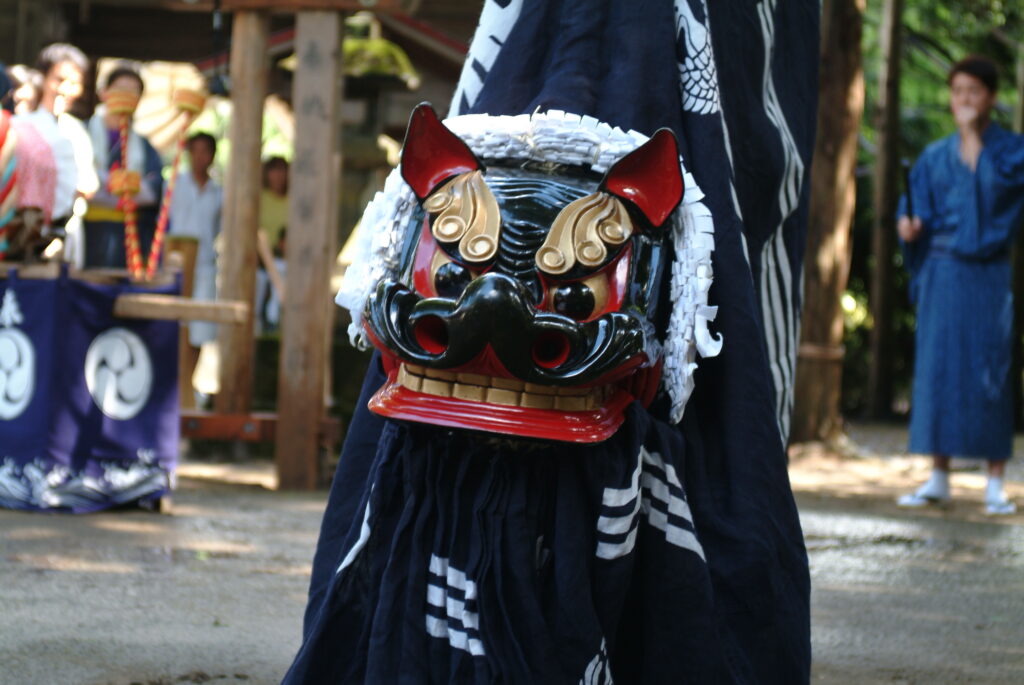
Oya Shishimai Lion Dance 大谷獅子舞
8:00 Shishi-mai performance
Location: Hosenji Temple (Okawado) 宝泉寺(大川渡)
- How to go:
-
By train: 30 min. walk from the Fujishima JR Station (itinerary)
August 15th (Friday)

Ike shrine’s Furukôri Kagura performance 古郡神楽
11:00 Kagura-mai (dance)
Location: Inside Ike shrine’s precincts 池神社境内
12:00 Official prayer ceremony
Location: Inside Ike shrine 池神社
- How to go:
-
By train: 28 min. walk from the Fujishima JR Station (itinerary)
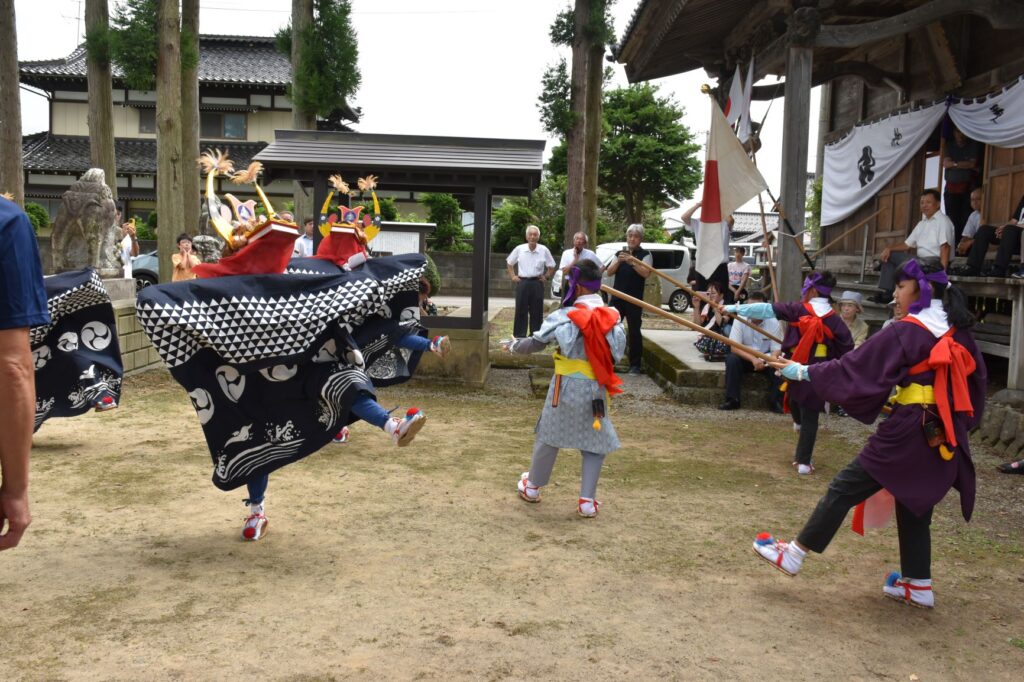
Gosho shrine’s Watamae Shishiodori (Children’s Lion Dance) 渡前獅子踊り(子ども獅子)
13:30 Official prayer ceremony
Location: Inside Gosho Shrine 五所神社
Around 14:00 Children’s Shishi Dance performance
Location: Inside Gosho Shrine’s precincts 五所神社境内
- How to go:
-
By train: 31 min. walk from the Fujishima JR Station (itinerary)
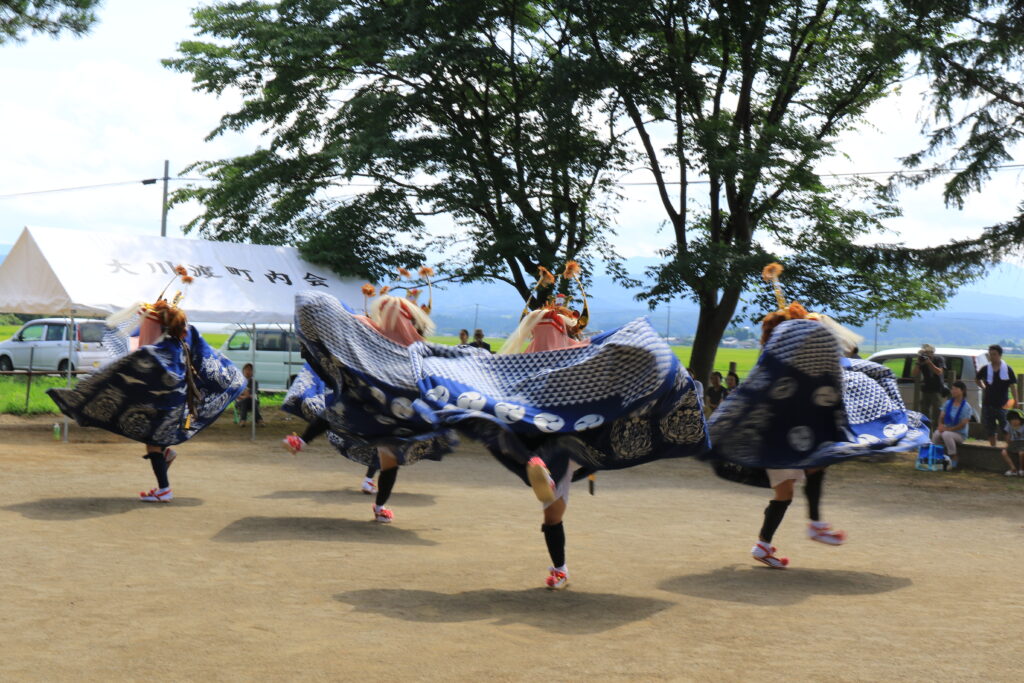
Ochi shrine’s Oya Shishimai Lion Dance 大地神社大谷獅子舞
10:00 & 19:00 Shishimai
Location: Ochi shrine’s precincts 大地神社境内
- How to go:
-
By train: 3.3km away from the Fujishima JR Station (itinerary)
Jumonji Kotai shrine’s Kagura performance 十文字皇大神社神楽
11:00 Kagura performance
Location: Jumonji Kotai shrine’s precincts 十文字皇大神社境内
- How to go:
-
By bus: take the bus bound for Mt. Haguro (Haguro Gassan-hachigome), get off the bus at Jyumonji, walk 1 minute to the shrine
August 16th (Saturday)
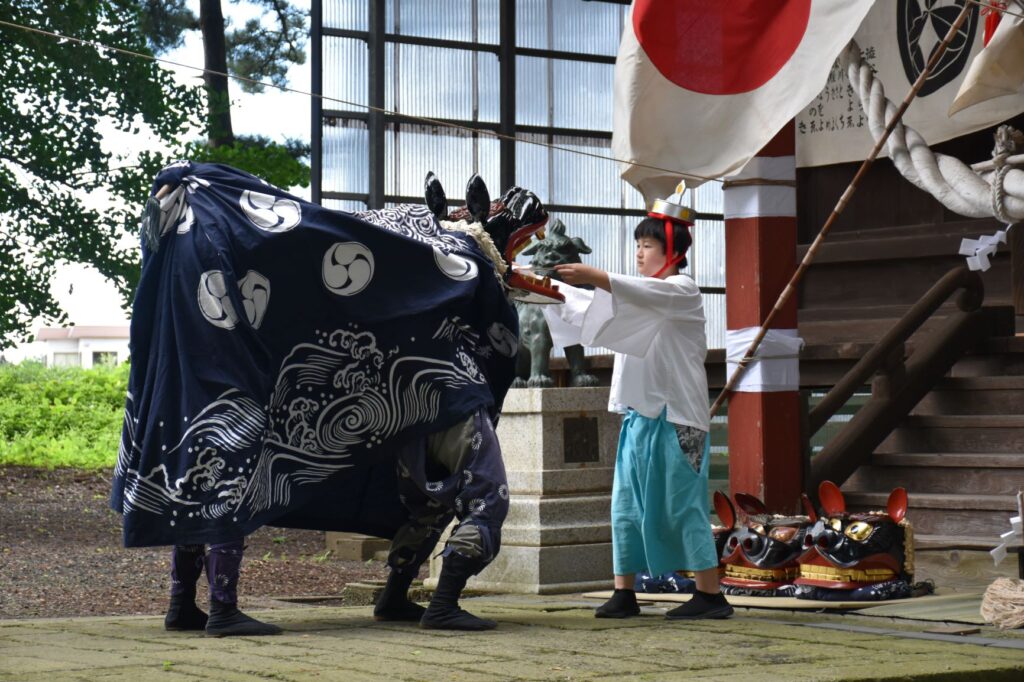
Naganuma Hachiman shrine’s Kagura performance 長沼八幡神社神楽
13:00 Official prayer ceremony
Location: Inside the Naganuma Hachiman shrine 長沼八幡神社
13:30 Kagura performance
Location: Naganuma Hachiman shrine’s precincts 長沼八幡神社境内
- How to go:
-
By car (easiest)
By bus: take the bus to Aeon Mikawa Bus Terminal, take a taxi from there (itinerary)
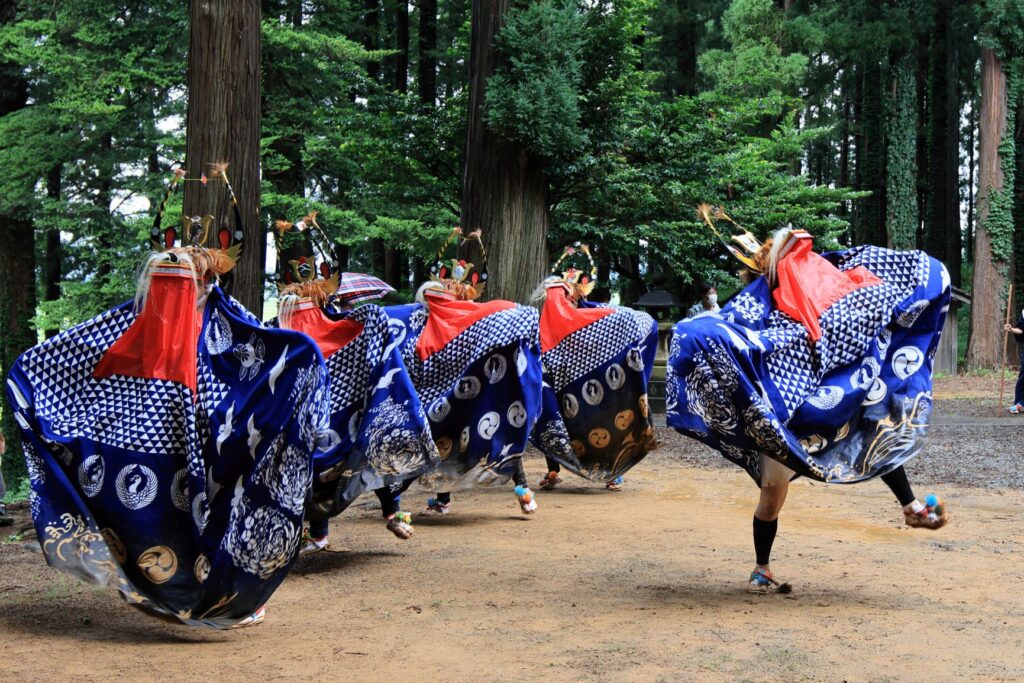
Niiyama Shrine’s Higashi Horikoshi Shishiodori Lion Dance 東堀越獅子踊り
13:00 Shishiodori Lion Dance
Location : Niiyama shrine’s precincts 新山神社境内
- How to go:
-
By car (easiest)
By bus: take the bus to Mt. Haguro (Haguro Gassan Hachigome), get off the bus at Haguro Kokomae, walk 3km (itinerary) to the shrine
August 18th (Monday)
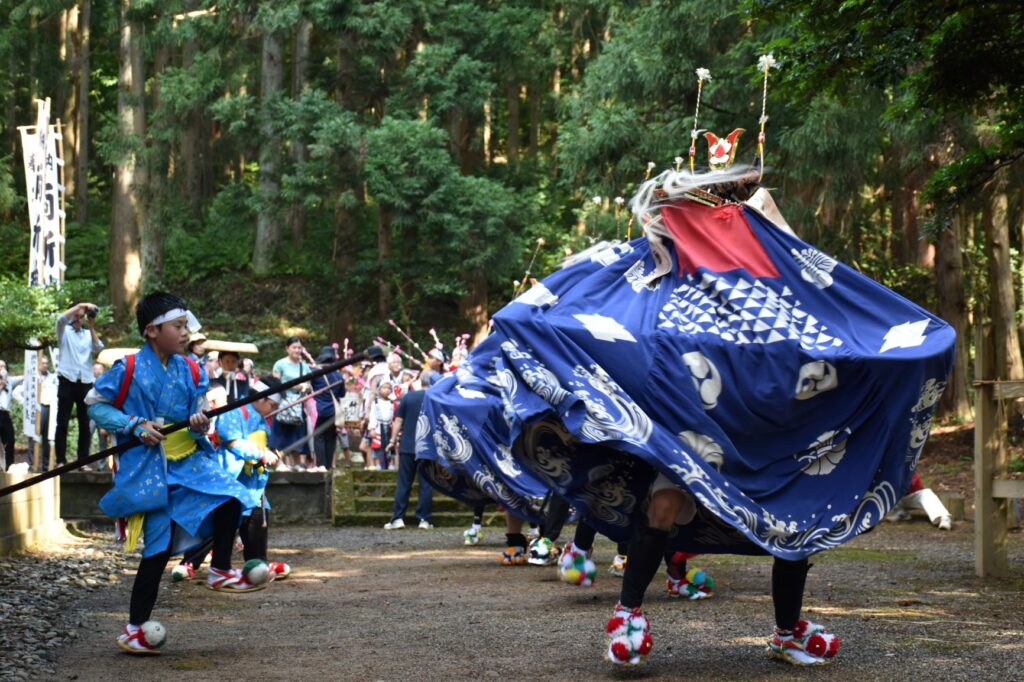
Soegawa Ryosho Shrine’s Shishimai (Lion Dance) 添川両所神社御獅子舞
13:00 Official Prayer Ceremony
Location: Soegawa Ryosho shrine 添川両所神社
14:00 Kuneri performance
Location: Soegawa Ryosho shrine’s precincts 添川両所神社
- How to go:
-
By car (easiest)
By bus: take the bus to Mt. Haguro (Haguro Gassan Hachigome), get off the bus at Haguroannaisho, walk 4km to the shrine (itinerary)
All the Shishimai performances on the map
(Open the map in a new tab to see the dates & times)
